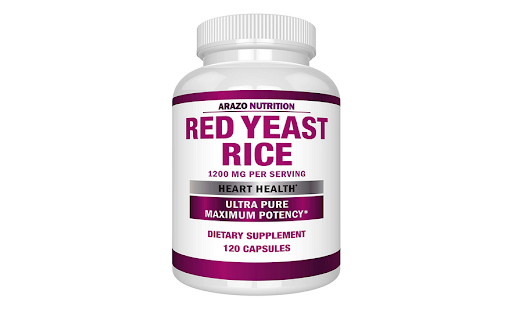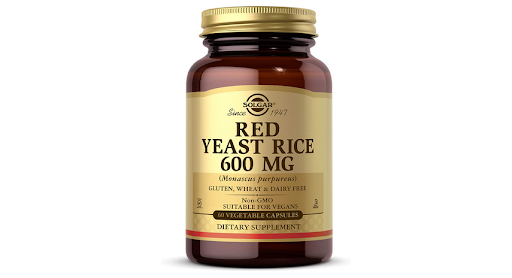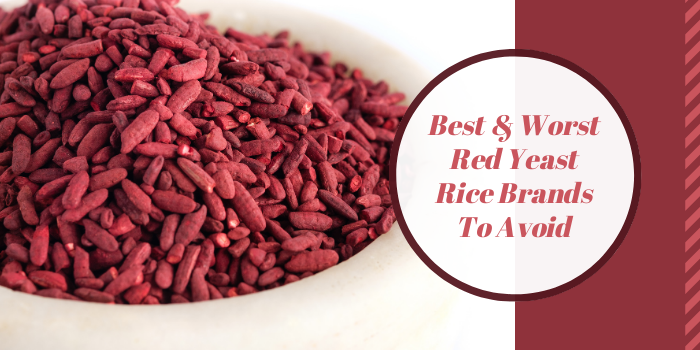
Red yeast rice is one of the most popular types of rice prized for its powerful medicinal properties.
The rice is a natural remedy for high cholesterol and one of the few that contains the active ingredients you’d ordinarily find in prescription medications. Not only that, but red yeast rice also may benefit metabolic syndrome, inflammation, and blood sugar levels among other ailments.
Plus, the rice is produced using a specific species of mold and has been used for centuries thanks to its Monacolin K compound, which is also found in lovastatin and similar prescription meds for lowering cholesterol.
If you’re looking for the best red yeast rice brands, it’s important to note that not all of them are made the same. There are some good and legit brands that contain the required ingredients including Monacolin K, but there are other brands you need to avoid.
Below you’ll find a list of the best brands to buy and the red yeast brands to avoid.
Best Red Yeast Rice Brands
1. Arazo Nutrition Red Yeast Rice
Some of the benefits you’ll get from this product include all-natural ingredients and it also claims to help you maintain healthy cholesterol levels. The product doesn’t need a prescription so you can purchase it over the counter.
Inside the pack, you’ll find 120 vegetarian capsules for 60 days. The product has a high potency with 1200 milligrams per serving of pure Monascus Purpureus extract. Plus, there’s no fermentation byproduct, which you would find in some brands, and it’s made in a GMP-certified facility in the US.
2. Nature’s Bounty Red Yeast Rice Pills and Herbal Supplement
Plus, they’re dedicated to consistency, quality, and scientific research, resulting in health products of unrivaled excellence.
This red yeast rice product by Nature’s Bounty contains a premium formula that’s US lab tested and audited by the USP and STR (specialized technology resources), both leading independent supplement quality evaluation firms.
The product contains rice flour, gelatin, silica, yeast (special ingredient), and vegetable magnesium stearate.
3. Solgar Red Yeast Rice
The vegetable capsules are non-GMO, KOF-K Kosher certified, and certified gluten-free so they’re suitable for vegans. However, it’s recommended that you take the capsules with Coenzyme Q-10.
In terms of ingredients, the product is free of wheat, dairy, gluten, yeast, soy, sodium, and sugar. Plus, there are no sweeteners, artificial flavors, or colors.
4. Weider Red Yeast Rice Plus
The product contains phytosterols that help reduce the amount of absorbed cholesterol.
Inside the bottle are 1200 milligram capsules that contain low sodium magnesium stearate, stearic acid, microcrystalline cellulose, silicon dioxide, cross caramel, medium-chain triglycerides, and soy. However, the supplement doesn’t contain Monacolin K.
1. HPF Cholestene Red Yeast Rice
This red yeast rice supplement by HPF Cholestene is produced from fermenting the Monascus Purpureus Went. The supplement is formulated to support healthy cholesterol levels and you can use it as part of your dietary and exercise program.
The ingredients include gelatin and the pack comes with 120 capsules, which you shouldn’t exceed four capsules within a 24 hour period. The product is gluten-free and Citrinin-free, plus there are no fillers – just the ingredients and the capsule.
Red Yeast Rice Brands to Avoid
1. Spring Valley Red Yeast Rice
From user reviews, the product doesn’t seem to work as it has side effects including stomach discomfort, headache, intermittent lightheadedness, and aches in the joints and bones.
Another user claimed that the product was flagged by the Assistant Attorney General of New York, who demanded that retail stores, including Walmart, stop selling it as it often contains none of the advertised products.
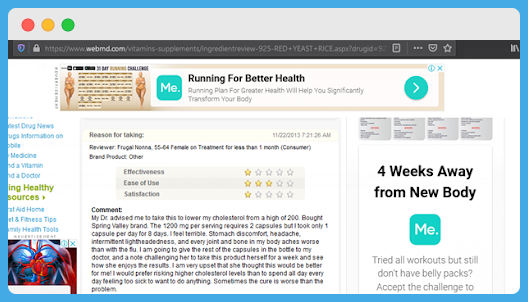
2. Solaray Red Yeast Rice
The 600-milligram red yeast rice VegCaps are tested for heavy metals, bacteria, pesticides, major allergens, and are certified by Nutraceutical’s lab for purity, identity, and potency.
While the company claims that every batch meets the highest quality standards, the statements aren’t evaluated by the FDA. Plus, one user said that the product gave them sharp pains in their lower left side (kidney area).
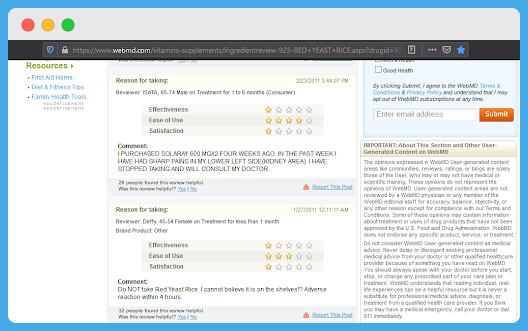
3. 21st Century Red Yeast Rice
Plus, we can’t verify its ingredients as there’s nothing in the product information to confirm its composition.
4. Now Foods Red Yeast Rice
The manufacturer recommends taking 2 vegetable caps of the dietary supplement 1-2 times every day preferably with meals. It’s also to be taken with CoQ10 capsules, chewable lozenges, and soft gels for enhanced benefit.
However, there’s not much about this product to warrant it being recommended as a suitable cholesterol-lowering supplement.
5. Nature’s Aid Red Yeast Rice
Inside is a pack of capsules containing 10 milligrams of Monacolin K, cellulose, silicon dioxide, and magnesium stearate. There are no artificial colors or flavors and it’s free from dairy, corn, lactose, gluten, nuts, wheat, soy, salt, sugar, and starch.
The manufacturer claims the product is made using the finest non-GM-approved rice for ultimate efficacy and purity. However, we cannot verify the efficacy of this product as yet because of its extremely low ratings and lack of user reviews.
What To Look For When Buying Red Yeast Rice
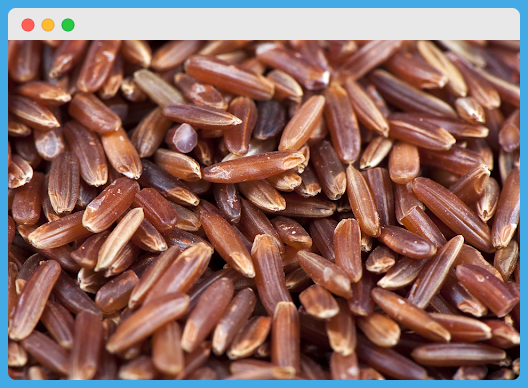
Before you go out and buy any of these red yeast rice brands, it’s important to note that there’s no simple answer as to which brand to trust or not to trust.
The supplement industry in the US is loosely regulated by the FDA (Food and Drug Administration), which acts to ensure products are made according to GMPs (good manufacturing practices).
Among these practices include cleanliness, potency, and stability, meaning that ingredients are generally safe and there are no unsubstantiated claims from manufacturers about treating or curing diseases.
On the other hand, the Federal Trade Commission (FDC) helps ensure that such companies aren’t engaging in deceptive advertising practices. Such restrictions on advertising tend to be bypassed with creative wording and marketing that implies specific health benefits, which the FDC seeks to control.
In the manufacture of red yeast rice and other supplements, there’s tremendous variability in the standards and controlling them from one company to another. This in turn makes picking an effective product more challenging.
However, if you want a good product, it’s better to buy from your nearest pharmacy, qualified health care professional like a naturopathic or medical doctor, or health food store.
You can also buy from large retail chain stores like Whole Foods Market, whose standards for evaluating supplements are very rigid so you’re assured they will carry only the quality and approved products.
Whenever possible, check for the U.S. Pharmacopeia (USP) label on any product you buy as this group sets standards for the most popular supplements. You can also check Consumerlab for any analysis of the ingredient contents of supplements or vitamin products.
In particular, red yeast rice should only be administered with your doctor’s or health care professional’s supervision. Just because red yeast rice is natural doesn’t make it completely safe or free of side effects in everybody.
Red yeast rice contains the same active compound as lovastatin and other cholesterol-lowering statin medications, which means it still requires some oversight by a doctor or medical professional.
Plus, red yeast rice may not have any known drug interactions and has fewer side effects compared to statins, but pregnant or nursing women and people with severe kidney or liver diseases should avoid it.
Make sure you eat a diet that’s healthy for your heart and exercise regularly in order to lower cholesterol even as you boost your health with cholesterol-lowering medication or supplements.
Wrapping Up
While red yeast rice is beneficial in reducing cholesterol levels, it’s important to know what you’re looking for when buying a red yeast rice supplement at your nearest pharmacy.
Remember to consult your physician and health professional before purchasing any product over the counter.

Diana Paul is a certified nutritionist who writes for leading health blogs. She is a master herbalist, yoga teacher, forager, and wild-crafting writer She is focused on helping people transform life blocks to opportunities. Based in NYC, she often holds health seminars and lectures.

